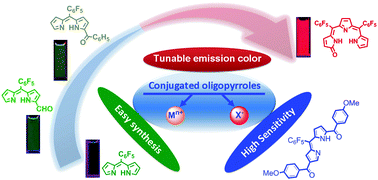Fluorescent and colorimetric ion probes based on conjugated oligopyrroles
Abstract
Metal ions and anions play important roles in many industrial and biochemical processes, and thus it is highly desired to detect them in the relevant systems. Small organic molecule based sensors for selective and sensitive detection of target ions show the advantages of low cost, high sensitivity and convenient implementation. In this area, pyrrole has incomparable advantages. It can be easily incorporated into linear and macrocyclic conjugated structures such as dipyrrins, porphyrins, and N-confused porphyrins, which may utilize the imino N and amino NH moieties for binding metal ions and anions, respectively. In this tutorial review, we focus on representative examples to describe the design, syntheses, sensing mechanisms, and applications of the conjugated oligopyrroles. These compounds could be used as colorimetric or fluorescent ion probes, with the advantages of vivid colour and fluorescence changes, easy structural modification and functionalization, and tunable emission wavelengths. Compared with normal porphyrins, simple di- and tripyrrins, as well as some porphyrinoids are more suitable for designing fluorescence “turn-on” metal probes, because they may exhibit flexible confirmations, and metal coordination will improve the rigidity, resulting in vivid fluorescence enhancement. It is noteworthy that the oligopyrrolic moieties may simultaneously act as the binding unit as well as the reporting moiety, which simplifies the design and syntheses of the probes.


 Please wait while we load your content...
Please wait while we load your content...